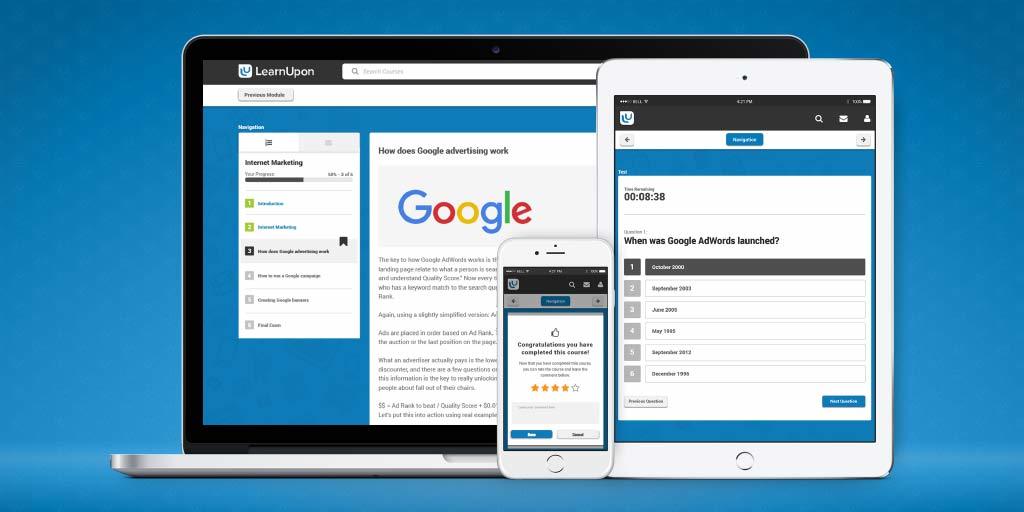How To Select The Right Learning Management System
If you’re thinking about investing in a Learning Management System (LMS), you’ll know that the market is bursting with almost 700 options. Navigating through them to select the right Learning Management System can seem daunting. Vendor websites start to look similar after a while, making it difficult to figure out who’s the best fit. At LearnUpon, we don’t do the hard sell. We work with you to understand your requirements and help you to decide quickly if our Learning Management System is a match. The checklist we use has helped hundreds of companies to focus on the considerations that matter most. If you want to select the right Learning management System, here are 5 major factors you should consider.
1. Features First
It’s important to select a Learning Management System that offers the right features. That doesn’t mean selecting the Learning Management System that offers the most features, either. Before your search begins, focus on prioritizing your requirements. When you’ve found 3-5 Learning Management Systems that look like a good fit, things like a demo and free trial will help you to narrow your search. But beware of unwanted features. A bloated and complicated system creates unnecessary problems you don’t need later. It will make implementing the Learning Management System and training staff difficult and time consuming. Unwanted features diminish user experience, distracting and confusing learners from key goals. The more complex your Learning Management System is, the longer it takes to educate users. That may even drive you to invest in additional training to minimize user discomfort. It can also threaten the continuity of programs if a key administrator leaves. Depending on the pricing model your Learning Management System vendor uses, you could also end up paying for features you don’t need.
2. Make It Responsive

A fully responsive Learning Management System is pretty much essential, so it can be surprising how many vendors lag behind. The demand for mobile learning (or mLearning) exploded over the last few years. Learners now want to access course content on phone and tablet devices, as well as desktop. A Learning Management System developed with responsive design can adapt to the range of screen sizes users may require. You should also consider if you need to offer access to your Learning Management System via mobile apps. The type of mobile support you need will depend on the range of devices and operating systems (like iOS, Windows, or Android) your organization wants to support. Research how vendors handle responsiveness. If a learner accesses course content on multiple devices, you need to know if progress is bookmarked in real time. Supporting mobile learning also has technical implications you need to assess vendors on. A responsive Learning Management System isn’t of much use if it fails to load in the browsers used by your company, for example.
3. Integrate With Existing Systems
A Learning Management System shouldn’t be assessed in isolation. To be effective, the platform should integrate widely with systems already used in your company. Integrating with features like a vendor’s API, single-sign-on (SSO), or webhooks can allow you to customize your Learning Management System for your organization’s most specific requirements. Implementing SSO allows learners to access your Learning Management System with the same set of credentials used for other platforms and applications. When webhooks are provided by a vendor, they allow you to send real-time information between your Learning Management System and other systems to automate processes. Customers integrate with LearnUpon’s API to create users, add them to groups, enroll them in courses, and extract user and course completion data. Some use our API to generate enrollments in courses from third-party apps. Others use the progress made by learners in LearnUpon to build gamification and leaderboards outside their Learning Management System.
4. The Right Price
Many different pricing models are used in the eLearning industry and some offer better value than others. Depending on your requirements, pricing models can add up to very different costs. Common pricing approaches include charging by usage volume or by a projected or real number of active or registered users. These different approaches can make it hard to compare quotes from multiple vendors. To do so, you should estimate projected usage and plug it into shortlisted models. If a pricing model is based on user or usage limits, ask what happens if you exceed limits. Automatic lock-outs may cause inconvenience and embarrassment later. Beyond the basic pricing model, request a full list of additional costs. There are any number of essential or optional services a Learning Management System vendor may charge for. Extra fees for things like set-up, installation, training, and cancellation can dramatically impact value.
5. Customer Support (Including Content Support)

If you’ve already implemented a Learning Management System, you’ll appreciate the value of great customer support. Even when a Learning Management System runs perfectly, you still need good customer support. Too many Learning Management System vendors treat customer support as a cost, leaving clients to struggle with integration, maintenance, and content alone. Those same vendors often make bold claims about the quality of their customer support. In order to really assess customer support, dig past the vendor’s marketing blurbs and put their service to the test. Basic information about hours and channels of communication will give you a sense of how much the vendor invests in customer support.
You should also assess your personal experience from the point of inquiry onwards. The speed and thoroughness with which questions are handled will indicate the level of care you can expect if you become a customer. At LearnUpon, we invested in delivering free 24/7 customer support from the beginning. Yet customers are often surprised to learn that, most of the time, the support they really need isn’t for the Learning Management System at all. Integrating content into a Learning Management System can throw up many issues, like the communication of completion statuses back to the Learning Management System. If you use an authoring tool with your Learning Management System, your vendor should understand both the tool and its outputs. Most tickets our team deals with are actually content related. If your vendor’s customer support only covers the platform, you could be left to struggle with issues like courses that won’t track alone.
Need more help to select the right Learning Management System? Check out the recording of our webinar Top 10 considerations to select the best LMS.









